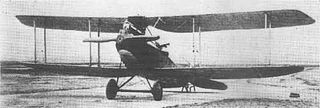
The Zeppelin-Staaken R.VI was a four-engined German biplane strategic bomber of World War I, and the only Riesenflugzeug design built in any quantity.

The Heinkel HE 1 was a two-seat, low-wing monoplane floatplane, designed in 1921 by German designer Ernst Heinkel at Caspar-Werke.
The Albatros L 58 was a German airliner of the 1920s. It was a single-engine cantilever monoplane which accommodated the pilot in an open cockpit at the top of the fuselage, and seated five-six passengers within it.

The Maybach Mb IVa was a water-cooled aircraft and airship straight-six engine developed in Germany during World War I by Maybach-Motorenbau GmbH, a subsidiary of Zeppelin. It was one of the world's first series-produced engines designed specifically for high-altitude use. It was quite different engine design than the previous Maybach Mb.IV, not just a simple modification.

Hansa-Brandenburg W.33 was a German two-seat, single-engined low-wing monoplane floatplane, which had been developed by Hansa und Brandenburgische Flugzeugwerke during World War I as a higher powered enlargement of the similar Hansa-Brandenburg W.29 and despite the increase in size the two types are very difficult to differentiate. Although the W.33 was built in small numbers during the war many license built versions were built after World War I.

The Rumpler C.VII was a military reconnaissance aircraft built in Germany during World War I. It was developed from the C.IV and optimised for high-altitude missions that would allow it to operate at heights that would render it immune to interception by enemy fighters. Work on the C.VII took place after a similar attempt to develop the C.III into a high-altitude machine as the C.V failed.

The Sablatnig P.III was an airliner produced in Germany in the early 1920s.
The Kawanishi K-7 Transport Seaplane was a Japanese single-engined biplane floatplane of the 1920s. Eleven were built from 1924 to 1927, being used to carry passengers and airmail.

The Zeppelin-Staaken Riesenflugzeuge were a series of very large bomber aircraft - Riesenflugzeuge, usually powered by four or more engines, designed and built in Germany from 1915 to 1919.

The Zeppelin-Lindau Rs.III was a large four-engined monoplane flying boat designed by Claudius Dornier and built during 1917 on the German side of Lake Constance at the Zeppelin-Lindau works.

The Fizir F1V was the basis from which engineer Rudolf Fizir developed a series of single-engined, two-seat, reconnaissance biplanes fitted with different engines. Construction was carried out in the Yugoslav aircraft factories Zmaj and Rogožarski between 1928 and 1932.

The Kawanishi K-8 Transport Seaplane was a Japanese single-engined floatplane of the 1920s. Seven were built in 1926 and 1927, and were used to operate airmail services.

The Rumpler C.X, produced under the company designation Rumpler 8C 14, was a German two-seat observation aircraft. It was developed from the earlier Rumpler 8C 13 prototype by Rumpler in early 1918. The prototype had a similar wing design to the Rumpler C.VII, powered by a 260 hp (194 kW) Mercedes D.IVa engine and was later powered by a 240 hp (179 kW) Maybach Mb.IVa. The C.X had the highest top speed and service ceiling of all German C-type aircraft and an order was placed for the aircraft in August 1918, but few were built and tested before the war ended.

The Zeppelin-Lindau Rs.IV was a Riesenflugzeug monoplane all metal flying boat with a stressed skin hull and fuselage developed for the Imperial German Navy to perform long range patrols over the North Sea. It had been developed by Claudius Dornier while working for Zeppelin in the town of Lindau.
The Halberstadt C.VIII was a prototype two-seat general-purpose biplane built by Halberstadt during World War I.

The Sablatnig C.II was a conventional C-type reconnaissance two-seater aircraft developed and built by Sablatnig in Berlin, Germany in 1918.
The Polikarpov PM-1 was a passenger aircraft created by Polikarpov in the 1920s.
The LFG Roland C.VIII was a German reconnaissance aircraft of World War I. It was manufactured by Luft-Fahrzeug-Gesellschaft G.m.b.H.
The Kawanishi K-10 Transport was a 1920s Japanese passenger and mail transport. Two were built, one briefly serving a route between cities in Japan, Korea and China.
The Kawanishi K-3 was a Japanese, fast, multi-purpose civil transport aircraft from the early 1920s. Despite its good performance it was eclipsed by the release of Army surplus machines and only one was built.












